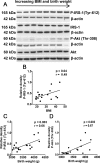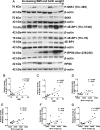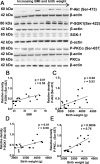Activation of placental mTOR signaling and amino acid transporters in obese women giving birth to large babies
- PMID: 23150676
- PMCID: PMC3537112
- DOI: 10.1210/jc.2012-2667
Activation of placental mTOR signaling and amino acid transporters in obese women giving birth to large babies
Abstract
Context: Babies of obese women are often large at birth, which is associated with perinatal complications and metabolic syndrome later in life. The mechanisms linking maternal obesity to fetal overgrowth are largely unknown.
Objective: We tested the hypothesis that placental insulin/IGF-I and mammalian target of rapamycin (mTOR) signaling is activated and amino acid transporter activity is increased in large babies of obese women.
Design and setting: Pregnant women were recruited prospectively for collection of placental tissue at a university hospital and academic biomedical center.
Patients or other participants: Twenty-three Swedish pregnant women with first trimester body mass index ranging from 18.5 to 44.9 kg/m(2) and with uncomplicated pregnancies participated in the study.
Interventions: There were no interventions.
Main outcome measures: We determined the phosphorylation of key signaling molecules (including Akt, IRS-1, S6K1, 4EBP-1, RPS6, and AMPK) in the placental insulin/IGF-I, AMPK, and mTOR signaling pathways. The activity and protein expression of the amino acid transporter systems A and L were measured in syncytiotrophoblast microvillous plasma membranes.
Results: Birth weights (range, 3025-4235 g) were positively correlated to maternal body mass index (P < 0.05). The activity of placental insulin/IGF-I and mTOR signaling was positively correlated (P < 0.001), whereas AMPK phosphorylation was inversely (P < 0.05) correlated to birth weight. Microvillous plasma membrane system A, but not system L, activity and protein expression of the system A isoform SNAT2 were positively correlated to birth weight (P < 0.001).
Conclusions: Up-regulation of specific placental amino acid transporter isoforms may contribute to fetal overgrowth in maternal obesity. This effect may be mediated by activation of insulin/IGF-I and mTOR signaling pathways, which are positive regulators of placental amino acid transporters.
Figures





Similar articles
-
Increased placental IGF-1/mTOR activity in macrosomia born to women with gestational diabetes.Diabetes Res Clin Pract. 2018 Dec;146:211-219. doi: 10.1016/j.diabres.2018.10.017. Epub 2018 Oct 31. Diabetes Res Clin Pract. 2018. PMID: 30389621
-
Apelin is a novel regulator of human trophoblast amino acid transport.Am J Physiol Endocrinol Metab. 2019 May 1;316(5):E810-E816. doi: 10.1152/ajpendo.00012.2019. Epub 2019 Mar 5. Am J Physiol Endocrinol Metab. 2019. PMID: 30835509 Free PMC article.
-
Activation of placental insulin and mTOR signaling in a mouse model of maternal obesity associated with fetal overgrowth.Am J Physiol Regul Integr Comp Physiol. 2016 Jan 1;310(1):R87-93. doi: 10.1152/ajpregu.00356.2015. Epub 2015 Oct 21. Am J Physiol Regul Integr Comp Physiol. 2016. PMID: 26491103 Free PMC article.
-
Placental function in maternal obesity.Clin Sci (Lond). 2020 Apr 30;134(8):961-984. doi: 10.1042/CS20190266. Clin Sci (Lond). 2020. PMID: 32313958 Free PMC article. Review.
-
Placental Function and the Development of Fetal Overgrowth and Fetal Growth Restriction.Obstet Gynecol Clin North Am. 2021 Jun;48(2):247-266. doi: 10.1016/j.ogc.2021.02.001. Obstet Gynecol Clin North Am. 2021. PMID: 33972064 Free PMC article. Review.
Cited by
-
Maternal obesity is associated with a reduction in placental taurine transporter activity.Int J Obes (Lond). 2015 Apr;39(4):557-64. doi: 10.1038/ijo.2014.212. Epub 2014 Dec 30. Int J Obes (Lond). 2015. PMID: 25547282 Free PMC article.
-
Morphological and molecular changes in the murine placenta exposed to normobaric hypoxia throughout pregnancy.J Physiol. 2016 Mar 1;594(5):1371-88. doi: 10.1113/JP271073. Epub 2015 Sep 15. J Physiol. 2016. PMID: 26278110 Free PMC article.
-
The Epidemiology and Mechanisms of Lifetime Cardiopulmonary Morbidities Associated With Pre-Pregnancy Obesity and Excessive Gestational Weight Gain.Front Cardiovasc Med. 2022 Mar 22;9:844905. doi: 10.3389/fcvm.2022.844905. eCollection 2022. Front Cardiovasc Med. 2022. PMID: 35391836 Free PMC article. Review.
-
Fetal undernutrition, placental insufficiency, and pancreatic β-cell development programming in utero.Am J Physiol Regul Integr Comp Physiol. 2018 Nov 1;315(5):R867-R878. doi: 10.1152/ajpregu.00072.2018. Epub 2018 Aug 15. Am J Physiol Regul Integr Comp Physiol. 2018. PMID: 30110175 Free PMC article. Review.
-
Gestational Diabetes Mellitus and Energy-Dense Diet: What Is the Role of the Insulin/IGF Axis?Front Endocrinol (Lausanne). 2022 Jun 23;13:916042. doi: 10.3389/fendo.2022.916042. eCollection 2022. Front Endocrinol (Lausanne). 2022. PMID: 35813659 Free PMC article. Review.
References
-
- Sebire NJ, Jolly M, Harris JP, Wadsworth J, Joffe M, Beard RW, Regan L, Robinson S. 2001. Maternal obesity and pregnancy outcome: a study of 287,213 pregnancies in London. Int J Obes Relat Metab Disord 25:1175–1182 - PubMed
-
- Ehrenberg HM, Mercer BM, Catalano PM. 2004. The influence of obesity and diabetes on the prevalence of macrosomia. Am J Obstet Gynecol 191:964–968 - PubMed
-
- Boney CM, Verma A, Tucker R, Vohr BR. 2005. Metabolic syndrome in childhood: association with birth weight, maternal obesity, and gestational diabetes. Pediatrics 115:e290–e296 - PubMed
-
- Mahendran D, Donnai P, Glazier JD, D'Souza SW, Boyd RD, Sibley CP. 1993. Amino acid (system A) transporter activity in microvillous membrane vesicles from the placentas of appropriate and small for gestational age babies. Pediatr Res 34:661–665 - PubMed
Publication types
MeSH terms
Substances
Grants and funding
LinkOut - more resources
Full Text Sources
Other Literature Sources
Medical
Miscellaneous

